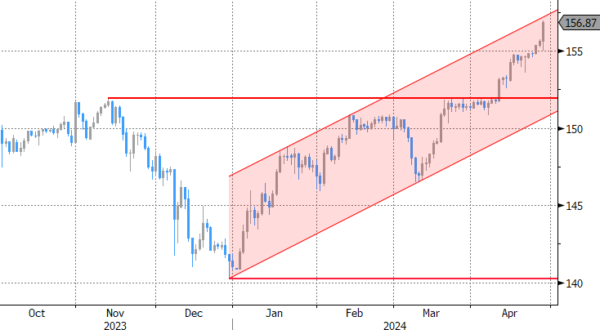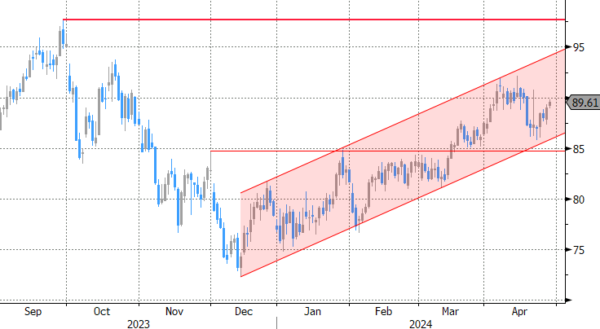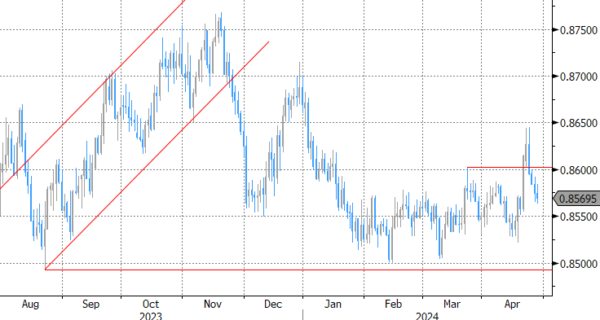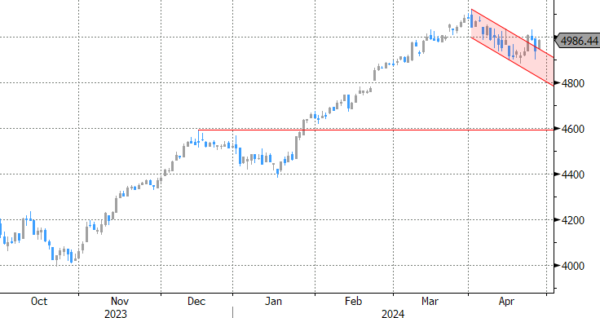Markets
The yen showed some huge intraday swings today. USD/JPY rose beyond 156 and was moving quickly towards 157 next. A violent countermove then pushed it back to the 155 figure only to trade back at the highest level of the day (and 34 years) just south of 157. It’s the kind of move you would expect on news the BoJ is “asking for quotes” in the market, typically the first step of an actual FX intervention. But in absence of confirming headlines, we assume it’s general market nervousness, amplified by the fact that Japanese markets are closed on Monday. That risks triggering more hefty price moves in liquidity-thinned trading. JPY investors are on high alert after this morning’s BoJ meeting disappointed once again. Inflation forecasts were revised higher but the policy-relevant gauge was seen just short of 2% over the policy horizon. This suggests the central bank is not yet fully convinced of prices moving towards target over the medium term. Governor Ueda at the press conference indeed noted that the trend is still below 2%. Said otherwise: there won’t be a follow-up rate hike to the March one just yet. Neither did the BoJ deliver on expectations here and there that it would tweak its bond buying programme. This puts Japanese monetary policy in ever stark contrast with the US. Solid economic growth and rusty, above-target inflation in combination with the upcoming November elections is closing the Fed’s window of opportunity to cut rates in no time. Today’s March PCE deflators coming in to the upside of expectations (2.7% headline, 2.8% core, both on a robust 0.3% m/m pace) with another batch of strong (real) personal spending and income data was testament. US money markets have pushed forward the timing of a first, fully priced in rate cut to December if we take November 7 – just days after the elections – out of the equation. The dollar is better bid against most G10 peers except for the commodity-linked ones (AUD, NZD, CAD). Note that the likes of Brent oil are returning stealth mode to their recent 7-month highs just shy of $90/b. Copper pierced through to a new 22-month high. EUR/USD called off an early attempt to rise to trade slightly lower in the 1.072 region. Nice equity gains (1%+ in Europe and 0.2-1.4% in the US) provide a cushion for the euro.
Core bonds licked their wounds ahead of the weekend. US and German yields roughly ease between 3 and 7 bps with the front end of the curve underperforming. Investors to some extend swooped in on the battered bonds after the PCE release today but it’s not very convincing so far. Especially with a heavy eco calendar next week, the risk is for getting burned. Brace yourselves for US ISMs, JOLTS job openings, the April labour market report, Treasury’s quarterly refunding scheme and the FOMC meeting. Europe is headed towards an avalanche of Q1 GDP (marking the low-point or even recovery in the cycle?!) and inflation numbers.
News & Views
The ECB’s March consumer expectations survey showed that median consumer inflation perceptions over the previous 12 months (5% from 5.5%) and inflation expectations for the next 12 months decreased (3% from 3.1%, the lowest level since December 2021). Inflation expectations three years ahead remain unchanged at 2.5%. This adds to the 25 bps rate cut case in June. Expectations for nominal income growth and nominal spending growth over the next 12 months decreased slightly, respectively to 1.3% and to 3.6%. The perception on economic growth over the next year is unchanged (-1.1%) while consumers turned less pessimistic on the labour market (expected unemployment rate of 10.7% from 10.9%). Finally, consumers expected housing prices to increase by 2.4% on a 1-yr horizon with mortgage rates forecast to fall slightly over the same time period (5% from 5.1%).
German Der Spiegel magazine reports that the federal government will have more borrowing leeway next year and is set to use it. Net new debt will be about €24bn in 2025 instead of the earlier flagged €16bn as the debt brake mechanism includes clauses in times of economic weakness. The figure compares to €70bn in 2023 and €40bn this year. All ministries except for defense (NATO goals of at least 2% of GDP spending on armed forces over the long term) have to do with less cash after the constitutional court ruled last year derailed the government’s finance planning with a ruling against the use of off-balance sheet funding to circumvent the debt brake.
Graphs
USD/JPY: how much longer can Japanese officials stand by and do nothing?

Commodities inlcuding Brent going towards their recent highs stealth mode.

EUR/GBP: sterling on track to erase last Friday’s slip-up with a nice weekly gain.

EuroStoxx50’s attempt to escape from a sell-on-upticks pattern needs further confirmation.










